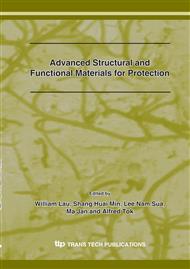[1]
P.G. Charalambides, J. Lund, A.G. Evans et al: Transactions of the ASME Vol. 56 (1989), pp.77-82.
Google Scholar
[2]
H.G.P. Chung, M.V. Swain and T. Mori: Biomaterials Vol. 18 (1997), pp.1553-1557.
Google Scholar
[3]
H. Li, K.A. Khor and P. Cheang: Surface and Coatings Technology Vol. 155 (2002), pp.21-32.
Google Scholar
[4]
N.P. O'Dowd, C.F. Shih and M.G. Stout: International Journal of Solids and Structures Vol. 29 (1992), pp.571-589.
Google Scholar
[5]
Jr T.L. Becker, J.M. McNaney, R.M. Cannon et al: Mechanics of Materials Vol. 25 (1997), pp.291-308.
Google Scholar
[6]
Tae Sung Oh, R.M. Cannon and R.O. Ritchie: Journal of the American Ceramic Society Vol. 70 (1987), p. C352-C355.
Google Scholar
[7]
R.M. Cannon, B.J. Dalgleish, R.H. Dauskardt et al: Acta Metallurgica et Materialia Vol. 39 (1991), pp.2145-2156.
DOI: 10.1016/0956-7151(91)90184-3
Google Scholar
[8]
G. Thun, G.A. Schneider, H-A. Bahr et al: Surface and Coatings Technology Vol. 123 (2000), pp.147-158.
Google Scholar
[9]
H.C. Cao and A.G. Evans: Mechanics of materials Vol. 7 (1989), pp.295-304.
Google Scholar
[10]
S.J. Howard, A.J. Phillipps and T.W. Clyne: Composites Vol. 24 (1993), pp.103-112.
Google Scholar
[11]
D. Muller, Y.R. Cho, S. Berg et al: International Journal of Refractory Metals & Hard Materials Vol. 14 (1996), pp.207-211.
Google Scholar
[12]
B. Moran and C. F. Shih: Engineering Fracture Mechanics Vol. 27 (1987), pp.615-642.
Google Scholar
[13]
C.F. Shih and R.J. Asaro: Transactions of the ASME. Journal of Applied Mechanics Vol. 55 (1988), pp.299-316.
Google Scholar
[14]
T. Nakamura, and D.M. Parks: International Journal of Solids and Structures Vol. 29 (1992), pp.1597-1611.
Google Scholar
[15]
Lianyong Xu, Hongyang Jing and Lixing Huo: Surface and Coatings Technology Vol. 201 (2006), pp.2399-2406.
Google Scholar
[16]
D.M. Parks: Computer Methods in Applied Mechanics and Engineering Vol. 12 (1977), pp.353-364.
Google Scholar
[17]
C.F. Shih, B. Moran and T. Nakamura: International Journal of Fracture Vol. 30 (1986), pp.79-102.
Google Scholar
[18]
F.M. Beremin: Metallurgical Transactions Vol. 14 (1983), pp.2277-2287.
Google Scholar
[19]
F. Minami, A. Bruckner-Foit, D Muaz et al: International Journal of Fracture Vol. 54 (1992), pp.197-210.
Google Scholar
[20]
Hongyang Jing, Lianyong Xu, Lixing Huo et al: Journal of Materials Science and Technology Vol. 20 (2004), pp.113-117.
Google Scholar
[21]
Hongyang Jing, Lianyong Xu, Lixing Huo et al: Journal of Materials Science and Technology Vol. 21 (2005), pp.1-4.
Google Scholar
[22]
Fumiyoshi Minami, S. Satoh and M. Tsukamoto et al: Symposium on Microjoining and Assembly Technology in Electronics, (2000), pp.67-72.
Google Scholar


